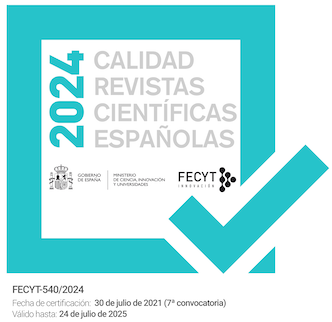Abuses of Power, Corruption and Oblivion in Melba Escobar's La Casa de la Belleza
DOI:
https://doi.org/10.30827/rl.v0i35.30705Keywords:
contemporary Colombian literature, literature and violence, corruption and villainy, postcolonial studiesAbstract
Melba Escobar's La Casa de la Belleza (2015) is interpreted as a portrayal of an elitist society with multiple defects, social inequalities and extraordinary corruption. This study shows how certain structural and legal injustices, such as the improper resolution of the rape and murder of a teenage girl, are actively provoked by politically powerful men. Methodologically, literary concepts of villainy are combined with theories on different types of violence and postcolonial, gender and memory studies to expose how male villains, especially the killer's father, abuse their power and use both bribery and violence to elevate themselves above the state system, represented by deliberately passive officials. The corruptibility of many of the characters and of a large sector of public institutions helps the antagonist to impose a defensive oblivion in order to distort the murder investigation.
Downloads
References
Assmann, Aleida. Formen des Vergessens. Gotinga, Wallstein, 2016.
Ayuso de Vicente, Victoria. Diccionario de términos literarios. Madrid, Akal, 1997.
Cámara, Enrique. “Villains in Our Mind”. Villains and Villainy, Anna Fahraeus / Dikmen Yakalı-Çamoğlu (eds.), Boston, Brill, 2011, 1–27.
Delgado Ricci, María del Mar. “Literatura de crímenes femenina y feminista en Colombia”. Revista Telar, 26, 2021, 141–160.
Dhondt, Reindert. “Cuerpos mutilados en La Casa de la Belleza”. Cuerpo y violencia: De la inermidad a la heterotopía, Alicia Montes / Cristina Ares (eds.), Buenos Aires, Argus-a, 2020, 63-85.
Escobar, Melba. La Casa de la Belleza. Barcelona, Seix Barral, 2015.
Español Casallas, Janneth. “Pilar Quintana y Melba Escobar. Disensos y consensos en las novelas La perra (2017) y La mujer que hablaba sola (2019)”. Catedral Tomada: Revista de Crítica Literaria latinoamericana, 8, 15, 2020, 252-279. DOI: https://doi.org/10.5195/ct/2020.489
Fahraeus, Anna & Yakalı-Çamoğlu, Dikmen. “Who are the Villainous Ones?: Introduction”. Villains and Villainy: Embodiments of Evil in Literature, Popular Culture and Media, Boston, Brill, 2011, VII- XII. DOI: https://doi.org/10.1163/9789401206808
Fuentes, Luz. “La agencia interpersonal frente al fracaso de la intersubjetividad en la casa de la belleza de Melba Escobar”, Revista iberoamericana, 274, 2021, 207-224. DOI: 10.5195/reviberoamer.2021.8038 DOI: https://doi.org/10.5195/reviberoamer.2021.8038
Galtung, Johan. Peace by peaceful means. Londres, SAGE, 1996.
Homann, Florian. “Schwarze Frauen als mehrdimensional diskriminierte Romanfiguren in der kolumbianischen Gegenwartsliteratur”. Intersektionalität und erzählte Welten, Verónica Abrego et al. (eds.), Darmstadt, wbg Academic, 2023, 111–131. DOI: https://doi.org/10.21248/gups.73818
López Giraldo, Isabel. “Melba Escobar”. Las memorias conversadas, 25 de diciembre de 2022, https://isalopezgiraldo.com/historias/personajes/melba-escobar/ [12.11.2024].
Lugones, María. “Colonialidad y género”. Tabula Rasa, 9, 2008, 73-101. DOI: https://doi.org/10.25058/20112742.340
Martin, Sara. “The Silent Villain”. Villains and Villainy, Anna Fahraeus & Dikmen Yakalı-Çamoğlu (eds.), Boston, Brill, 2011, 29–45. DOI: https://doi.org/10.1163/9789401206808_003
Peacock, Melinda. “Gender Violence in La Casa de la Belleza by Melba Escobar”. PANDION, 3, 1, 2022, 1-6.
Spivak, Gayatri. ¿Pueden hablar los subalternos? Traducción de Manuel Asensi Pérez. Barcelona, MACBA, 2010.
Teo, Thomas (2014): “Epistemological Violence”. Encyclopedia of Critical Psychology, Nueva York, Springer, 593-596. DOI: https://doi.org/10.1007/978-1-4614-5583-7_441
Zouidi, Nizar (2021): “Introduction”. Performativity of villainy and evil in Anglophone literature and media. Basingstoke, Palgrave, XIII-xxxv. DOI: https://doi.org/10.1007/978-3-030-76055-7
Downloads
Published
How to Cite
Issue
Section
License
Copyright (c) 2025 Florian Homann

This work is licensed under a Creative Commons Attribution-NonCommercial 4.0 International License.
Revista Letral is an open access journal under a Creative Commons Atribución-NoComercial 4.0 license.
The works published in this journal may be reused, distributed and publicly presented for non-commercial purposes, provided that: cite the authorship and the original source of the publication (journal, publisher and URL of the work).
We strongly recommended you to share our published articles in social and scientific networks, institutional and public repositories, personal or institutional websites, blogs, Google Scholar, ORCID, ResearchID, ScopusID, etc.
The journal allow the author(s) to hold the copyright and to retain publishing rights without restrictions.
We are completely free, both for readers and authors.














